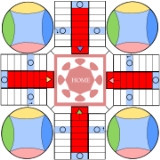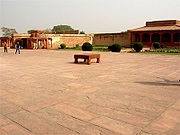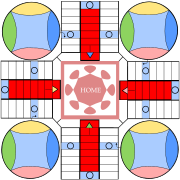
Parcheesi
Encyclopedia
Parcheesi is a brand name American
adaptation of the Indian Cross and Circle game
Pachisi
. Created in India
perhaps as early as 500
AD
, the board game is subtitled Royal Game of India because royalty played using color-costumed members of their harems as pieces on large outdoor boards. Such a court is preserved at Fatehpur Sikri
(image at right). The game and its variants are known worldwide; for example, a similar game called Parchís
is especially popular in Spain
, and Parqués
is a Colombian variant. A version is available in the United Kingdom under the name of Ludo
.

 Parcheesi is played with one or two dice
Parcheesi is played with one or two dice
and the goal of the game is to move each of one's pieces home to the center space. The most popular Parcheesi boards in America have 72 spaces around the board, twelve of which are darkened safe spaces where a piece cannot be captured.
Each player selects four pieces of the same color and places them in their "nest," or starting area. The game board should be positioned so that each player's nest is to his right. Pieces enter play onto the darkened space to the left of the nest and continue counter-clockwise around the board to the home path directly in front of the player.
Each player rolls a die; the highest roller goes first, and subsequent play continues to the left. On each turn, players throw one or both dice and use the values shown to move their pieces around the board. If an amount on one or both of the dice cannot be moved, that amount is forfeited.
Any time a player rolls, he must use as much of the dice showing as possible. (E.g., if a player rolls 4 and 5 and could move either 4 or 5, but not both, then he must move 5.)
Team Rules: If opposing team has two pawns on player's entering area, the player can not enter.
Two pieces that form a blockade are also safe.
When a double (doubles) is tossed before all four pawns have been entered, the player takes his turn as usual and gains another roll of the dice. In addition they can split the roll between two pawns.
When a double is tossed after all four pawns are entered, values on the reverse side of the dice are also used. For example, a player who rolls 6-6 can also move 1-1 in any combination. Therefore, when a double is tossed, the player has a total of fourteen spaces to move one or more pawns. If the player cannot move the entire number of spaces, he cannot move any spaces, but still gets to roll again.
The third consecutive doublet rolled in one turn is a penalty, and no pawns are moved forward. A player with a three doublet penalty also removes his pawn closest to home back to their nest, and his turn ends. Pawns can be moved off of the home path in this case, but not off of the home square.
A player cannot split doubles in order to enter home. This means that a player can only enter home by rolling doubles if he is exactly 14 spaces from home.
Each player has his own home path and may not enter another's. So, when a piece is on its home path, it can no longer be captured by an opponent. Pieces can still be removed from the home path as a result of the penalty for rolling three consecutive doublets.
United States
The United States of America is a federal constitutional republic comprising fifty states and a federal district...
adaptation of the Indian Cross and Circle game
Cross and Circle game
Cross and Circle is a board game design used for race games played throughout the world.-Design:Strictly, the design comprises a circle divided into four equal portions by a cross inscribed inside it; the classic example of this design is Yut...
Pachisi
Pachisi
Pachisi is a cross and circle board game that originated in ancient India which has been described as the "national game of India". It is played on a board shaped like a symmetrical cross...
. Created in India
India
India , officially the Republic of India , is a country in South Asia. It is the seventh-largest country by geographical area, the second-most populous country with over 1.2 billion people, and the most populous democracy in the world...
perhaps as early as 500
500
Year 500 was a leap year starting on Saturday of the Julian calendar. At the time, it was known as the Year of the Consulship of Patricius and Hypatius...
AD
Common Era
Common Era ,abbreviated as CE, is an alternative designation for the calendar era originally introduced by Dionysius Exiguus in the 6th century, traditionally identified with Anno Domini .Dates before the year 1 CE are indicated by the usage of BCE, short for Before the Common Era Common Era...
, the board game is subtitled Royal Game of India because royalty played using color-costumed members of their harems as pieces on large outdoor boards. Such a court is preserved at Fatehpur Sikri
Fatehpur Sikri
Fatehpur Sikri is a city and a municipal board in Agra district in the state of Uttar Pradesh, India. Built near the much older Sikri, the historical city of Fatehabad, as it was first named, was constructed by Mughal emperor Akbar beginning in 1570...
(image at right). The game and its variants are known worldwide; for example, a similar game called Parchís
Parchís
Parchís is a Spanish board game of the Cross and Circle family. It is an adaptation of the Indian game Pachisi.Parchís was a very popular game in Spain at one point, and it is still popular. Since it uses dice, Parchís is not usually regarded as an abstract strategy game like checkers or chess...
is especially popular in Spain
Spain
Spain , officially the Kingdom of Spain languages]] under the European Charter for Regional or Minority Languages. In each of these, Spain's official name is as follows:;;;;;;), is a country and member state of the European Union located in southwestern Europe on the Iberian Peninsula...
, and Parqués
Parques
Parqués is the Colombian version of a board game in the cross and circle family . The game is described as a "random thinking" game: the moves depend on the roll of the dice but players must consider possible strategies before executing their move...
is a Colombian variant. A version is available in the United Kingdom under the name of Ludo
Ludo (board game)
Ludo is a simple board game for two to four players, in which the players race their four tokens from start to finish according to dice rolls. Like other cross and circle games, it is similar to the Indian Pachisi, but simpler...
.

Rules of play

Dice
A die is a small throwable object with multiple resting positions, used for generating random numbers...
and the goal of the game is to move each of one's pieces home to the center space. The most popular Parcheesi boards in America have 72 spaces around the board, twelve of which are darkened safe spaces where a piece cannot be captured.
Each player selects four pieces of the same color and places them in their "nest," or starting area. The game board should be positioned so that each player's nest is to his right. Pieces enter play onto the darkened space to the left of the nest and continue counter-clockwise around the board to the home path directly in front of the player.
Each player rolls a die; the highest roller goes first, and subsequent play continues to the left. On each turn, players throw one or both dice and use the values shown to move their pieces around the board. If an amount on one or both of the dice cannot be moved, that amount is forfeited.
Any time a player rolls, he must use as much of the dice showing as possible. (E.g., if a player rolls 4 and 5 and could move either 4 or 5, but not both, then he must move 5.)
Entering pawns
Five has a special value in entering pieces out of the nest from where they begin the game. A player may enter a piece only by throwing a five or a total sum of five on the dice. Each time a five is tossed, the player must start another piece, if viable.Capturing
Any piece that is not on a safe space or a part of a blockade can be captured by an opposing pawn. A player is awarded 20 bonus spaces for capturing an opposing piece. The 20 spaces may not be divided between pieces and must be moved, if possible. The captured pawn is returned to the opposing player's nest.Team Rules: If opposing team has two pawns on player's entering area, the player can not enter.
Blockades
When two pieces occupy the same space, they prevent any pieces behind the two from advancing past the blockade. This includes blocking pieces from leaving their nest. Two pieces that form a blockade may not be moved forward together to form a new blockade on the same roll.Safe spaces
The dark spaces are safe spaces. A piece may not be captured as long as it sits on one of these spaces. The only exception is if a piece sits on the safe space where another player enters the board from his nest. Those spaces are safe from all other players, but the piece can be taken if the player whose nest it is has a piece in his nest and rolls a 5 (as long as it isn't a blockade).Two pieces that form a blockade are also safe.
Doubles
(Two dice version)When a double (doubles) is tossed before all four pawns have been entered, the player takes his turn as usual and gains another roll of the dice. In addition they can split the roll between two pawns.
When a double is tossed after all four pawns are entered, values on the reverse side of the dice are also used. For example, a player who rolls 6-6 can also move 1-1 in any combination. Therefore, when a double is tossed, the player has a total of fourteen spaces to move one or more pawns. If the player cannot move the entire number of spaces, he cannot move any spaces, but still gets to roll again.
The third consecutive doublet rolled in one turn is a penalty, and no pawns are moved forward. A player with a three doublet penalty also removes his pawn closest to home back to their nest, and his turn ends. Pawns can be moved off of the home path in this case, but not off of the home square.
A player cannot split doubles in order to enter home. This means that a player can only enter home by rolling doubles if he is exactly 14 spaces from home.
Home
The center home space can only be entered by exact throw of the die or dice. When a pawn enters the center space by exact count, that player is awarded ten movement points that may be moved with any one pawn still in play at the end of their turn. If the entire bonus movement amount cannot be used by one pawn, it is forfeit.Each player has his own home path and may not enter another's. So, when a piece is on its home path, it can no longer be captured by an opponent. Pieces can still be removed from the home path as a result of the penalty for rolling three consecutive doublets.

